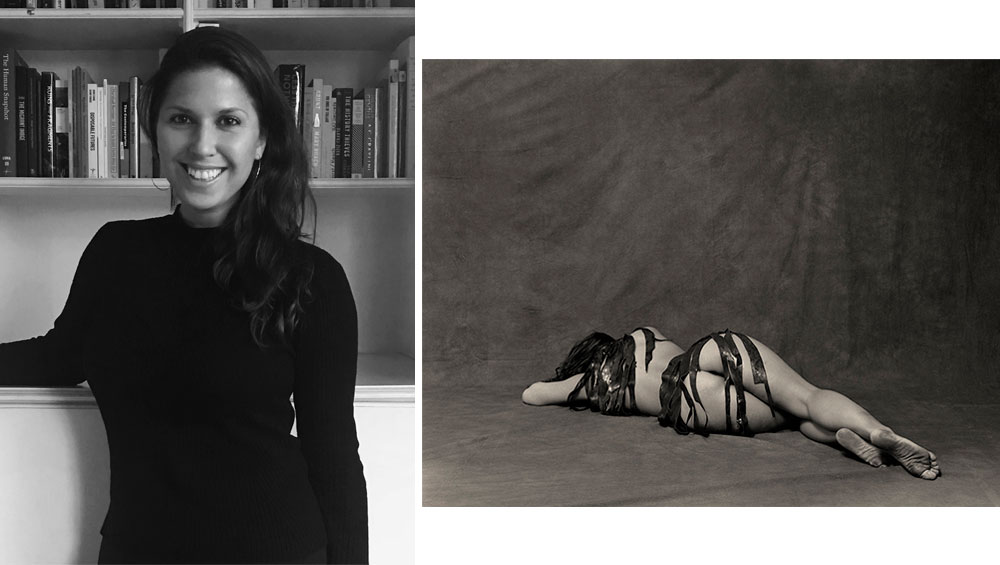
Photo © Esther Teichmann
by EMILY SPICER
The German-American artist Esther Teichmann (b1980) is drawn to dark places, be it ancient caves, the ocean depths or the darkroom. Her exhibitions are immersive experiences, wherein entire walls are covered in subterranean scenes, printed from photographs and painted in saturated hues. For her exhibition On Sleeping and Drowning, at Flowers Gallery in London last year, she accompanied these psychedelic images with monochrome prints of nude figures in grottos or splayed out on studio floors, draped in tentacular lengths of seaweed.
Also included in the exhibition was a film, Fulmine, in which the dancer Sophia Wang curls and stretches to the accompaniment of a string quartet playing a score written by the Irish composer Deirdre Gribbin. Taken as a whole, these works combine desire and fantasy with threat and surrender in a philosophical mire inspired in part by the writings of Georges Bataille and Marguerite Duras. Teichmann also writes, and her short stories take on these same themes. Heavy the Sea, which accompanied an exhibition of the same title, tells of a woman who slips out at night, leaving her lover in bed. She is drawn to the ocean and is almost drowned because she cannot tear herself away from the thrill of it.
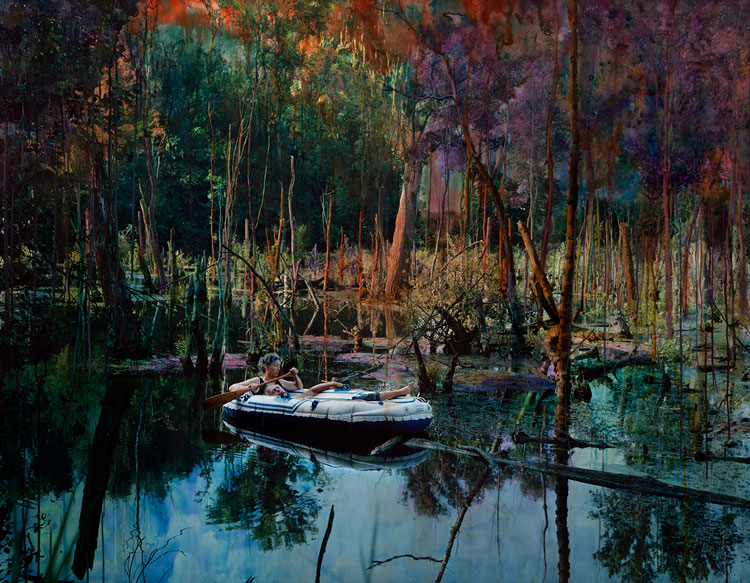
Esther Teichmann. Untitled from Mythologies, 2012-2014. Hand-painted chromogenic print. Courtesy the artist, Flowers Gallery and Galerie Les Filles du Calvaire.
Much of Teichmann’s work combines fantasy and the biographical, myth and experience. In the Mythologies series, one photograph depicts her parents in a rubber dinghy, paddled by her mother. The fragile raft floats through an inky swamp, coloured by hand in oily hues that are at once beautiful and threatening. The scene is tender and melancholy, otherworldly, yet dripping in foreboding, as the inflatable negotiates the dead wood of an environment that is ethereal, but also bordering on the post-apocalyptic. This image was taken near the family home, in the Rhine valley, where Teichmann grew up and where her parents still live.
Teichmann now lives and works with her partner and baby girl in London and lectures at the Royal College of Art, but she regularly visits the family home in Germany. When we spoke via Skype, she was isolating there with her parents, while her partner remained in the UK, unable to join them because of the travel bans put in force to curtail the spread of Covid-19. We spoke about photography, motherhood and lockdown and what the future holds for her work.
ES: Your work is multimedia in many ways, but photography seems to form the core of your practice.
ET: Photography is always at the centre of my practice and was definitely my starting point. I think it’s such an elastic and physical medium, but fundamentally the thing that draws me in is the relationship between the real and the staged, the duality between the real and the constructed, the world that exists and the otherworldly. It’s this dynamic that keeps me wedded to the medium and continually excited by it.
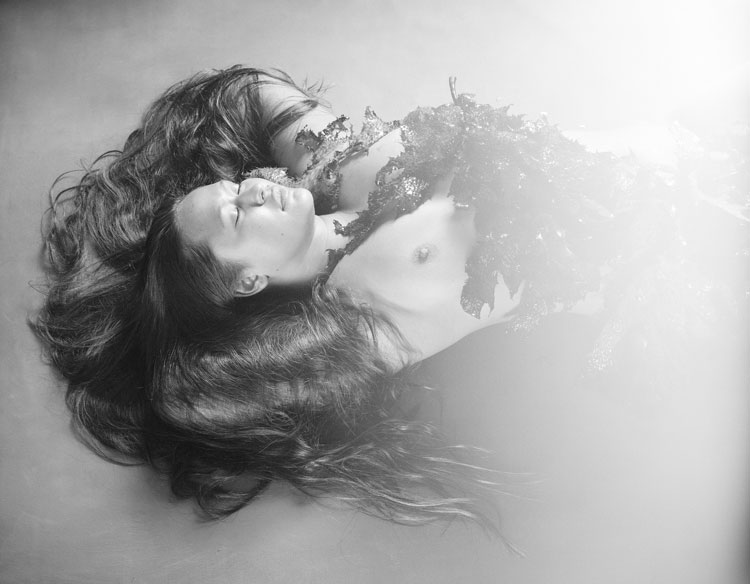
Esther Teichmann. Untitled from Heavy the Sea, 2017. Hand printed silver gelatin print. Courtesy the artist, Flowers Gallery and Galerie Les Filles du Calvaire.
I’ve noticed, too, that there is often quite a long time deferral between when I shoot something and the physical outcome. That’s the case with the work I’m shooting now on large-format cameras – I often won’t see the final work for several months, and with lockdown, much longer. Even under normal circumstances, I don’t rush to process and print the film. Once I’ve seen it under the dark cloth, projected on the glass, I almost don’t need it to exist in the world.
ES: Much of your work centres on the sea. What is your personal connection to the sea?
ET: Water is, literally and symbolically, central to my work. I grew up in a very watery place near lakes, close to the Rhine. The painted photograph of my parents in the dinghy was taken five minutes from my house. This wet swampy landscape is everywhere around me here and has been visually and emotionally formative.
Being in water was a huge part of my childhood. I spent many family vacations as a child on canoeing trips throughout Germany, other parts of Europe and at my mother’s home in upstate New York. This feeling of movement and the sense of a parallel world is a huge part of my work. You could drive the stretches that we canoed in a day, but we would take weeks, my parents and three small children. We all looked feral by the end! Wild camping under the stars was magical, frightening and exciting. I like that sense of enclosure and of everyone sleeping on top of each other in this other world. In the coming weeks, I’m working on going back to the beginning, creating images using our old canoes, kayaks and tents, which now have these amazing faded colours.
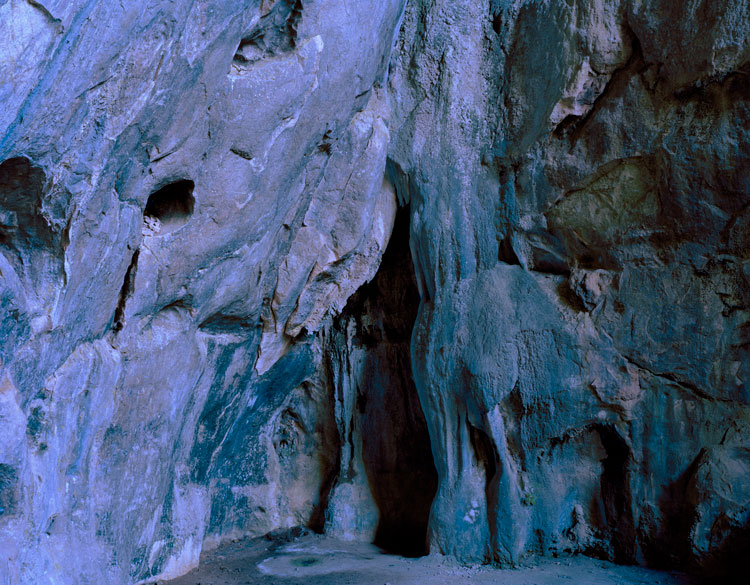
Esther Teichmann. Untitled from Heavy the Sea, 2018. Chromogenic print. Courtesy the artist, Flowers Gallery and Galerie Les Filles du Calvaire.
ES: Venus was born of the sea, Medusa’s blood was said to have formed from red coral. Sailors told tales of mermaids and sirens and, of course, there’s the Lady of the Lake from Arthurian legend. Watery places in general are so often associated with the female. Why do you think that is?
ET: A big part of my work explores our relationship to the maternal and homesickness, thinking about the mother as first lover and the fantasy of returning to our original home, to a place before memory. Caves and the ocean collide with the uterine. I’m also really interested in our bodies as possible homes to others as well as a non-biological motherhood, the experience, for example, of loving and mothering my sister’s children before I had my own. I’m really interested in the relationship that women have to each other, the physical and emotional intertwining and intensity. I grew up with my sisters, sleeping in one bed, and we remain very close.
Often, when I wake up, for a split second I’m not quite sure who I’m holding, whether it’s my mother or sister, partner or daughter. I’m interested in those imprints of memory and how they repeat like Russian dolls. I’m working on a new short story describing the experience of being held by my mother in the sea while I was pregnant, and thinking about my daughter inside me with all her eggs already formed. It occurred to me that my mother was holding all of her potential great grandchildren, and I like the strangeness and wonder of that.
ES: Has motherhood changed you as an artist?
ET: I think so, in that it has changed me as a person. It feels incredibly inspiring creatively, as well as all-consuming. The experience of giving birth was also otherworldly and I’ve been thinking a lot about how that experience seems to evade language; I don’t quite know how to describe it. Those hours were like nothing I had ever experienced before. When she crowned and was coming out, it felt like something she was doing and I couldn’t have stopped it if I had wanted to. It was as though this crazy, powerful, surging creature was swimming out of me into the birthing pool.
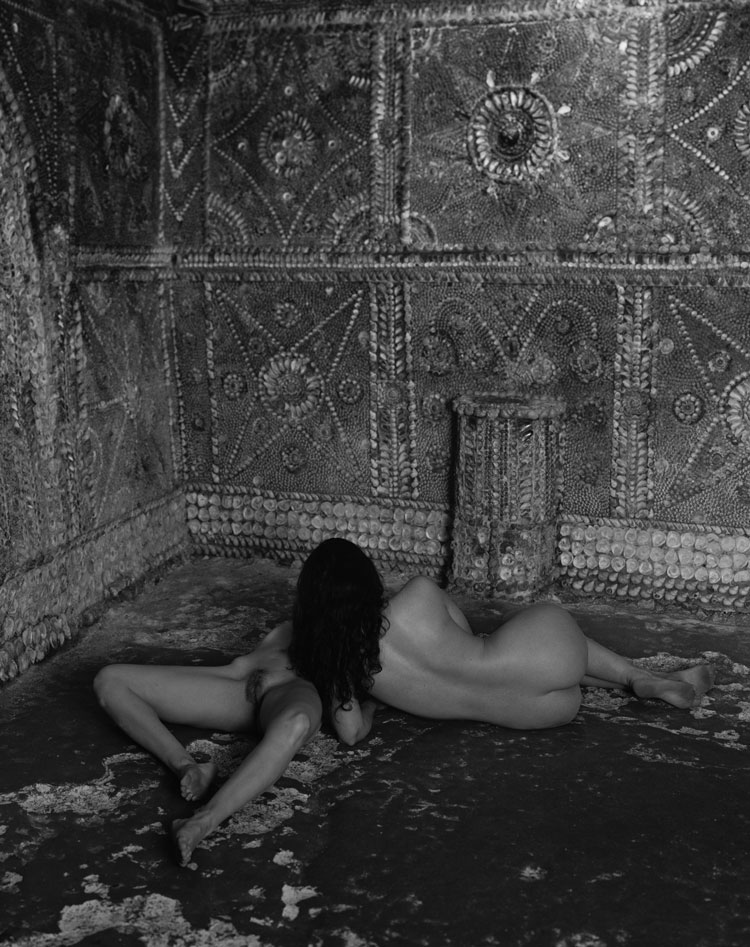
Esther Teichmann. Untitled from Fractal Scars, Salt Water and Tears, 2014. Fibre based silver gelatin print. Courtesy the artist, Flowers Gallery and Galerie Les Filles du Calvaire.
I had the most incredible NHS midwife, and her presence in those final hours of labour in our home was one of the most intimate, emotional experiences I have had. I don’t think I have ever felt more taken care of by someone. I don’t know if I’d recognise her if I passed her in the street, but just looking into the eyes of something who fully knows what’s happening in your body, and guiding you through it in the final stages, was the weirdest thing. It was like having the most amazing dance partner.
ES: Is being at home during lockdown at your parents’ house in Germany helpful to your work in a surprising way?
ET: It’s somewhere I come back to and make work a lot. I had planned to spend the summer here during my maternity leave. But to be here for longer and alone, without any other siblings or my partner, just me and the baby and my parents, is quite a gift – says the middle child! It feels quite exciting to be staying here for several months, and to be including my mother and baby in the work.
ES: The theme of loss and mourning runs through much of your writing.
ET: Yes, I am interested in the production of the work of art in relation to loss and mourning and the repetition of mourning; the paradox of each loss being unique and yet an echo of what has been before and is to come. I am also interested in the universality of this most intense singular experience. As children, we all have the realisation of the losses to come, the future loss of our parents, and we perform imagined rehearsals for this most unimaginable horror. I’m interested in that rehearsal and its function.
ES: Do you think that the drive to make art comes from wanting to achieve a sort of immortality, to leave behind a legacy?
ET: Perhaps – I’m not sure. I don’t think in the first instance, although maybe on some unconscious level. I don’t feel tied to that idea at all and think there is a weight in it that feels burdensome. I actually like destroying old work that doesn’t feel right any more and feel relieved not have a huge amount of material things in my life, even though my work is very material and quite messy and expansive. I find making larger books – which have probably the most longevity – quite stressful, that thought of permanence, although it is also really exciting. I say this as I am working on the final stages of a large monograph of images and writing.
ES: How is your relationship to photography evolving and how do you think it will continue to develop?
ET: In some ways it has been quite hard to work over the past nine months with a new baby. But there has been time to think and read, to figure out what the work means and who I am. Today, I found a bunch of old tents and sleeping bags and materials in my parents’ cellar and barn, and I feel so excited to work with the actual objects of my childhood, to turn them into fantastical sets. I’ve already used some objects from home in my work, such as one of my father’s foldable wooden kayaks, which I have made into multiple sculptural pieces. And the new pictures I have been working on in the last few weeks feel like a continuation, as well as something quite new and exciting, which is a huge relief.
ES: What is next for your work?
ET: My partner and I are working on a new collaborative project; a moving image work supported by the Wellcome Trust in response to a global scientific project called the Human Cell Atlas, which my sister, Sarah Teichmann, co-leads. We had been discussing the project for years, as it is not only scientifically and medically important, but also interesting historically and philosophically. We are really interested in the relationship between the visible and the invisible in photography and the technology of seeing – in what can be known and what is not (yet) known, exploring the parallels and intersections between science and the arts, between discovery and the imagination. For this project, we are working with scientists and historians of science and medicine, as well as the incredible composer Deirdre Gribbin. The Wellcome Collection houses such weird and wonderful materials, much of which is online and open access. It is an inspiring and expansive resource for artists and researchers!
Heavy the Sea
She wakes to find herself within the moon’s spotlight, a warm breeze moving across them. Breaking waves echo rhythmically, curtains billowing a strange dance.
They arrived late in the night too tired to drive on, a journey without destination or end. Days of driving through winding rainforest roads, warm afternoon rain lashing against the steamed-up windshield. She slides from under his arms, holding her breath. Slipping out, she closes the door softly.
The moon seems larger, closer to earth – everything feels alive in this too bright night. Her mother had told her she had been born at full moon, the maternity ward so crowded babies were delivered in hallways. She imagines the symphony of cries like baying wolves, the moonshine bathing bulging stomachs and writhing, blood-soaked-pink flesh in opalescent blues.
Still warm cement turns to sand as she runs towards glittering waves, eyes never leaving their hypnotizing call. One long inhale calms the cold sting of their crashing against shins, then thighs. Slowed only for a moment, she dives into blackness. A perfect arch with a force much greater than her body usually allows. Hurtling into and through dark water, everything inside her breathes with strength and relief. She swims down and away from land, eyes open, seeing nothing, saltwater entering every pore. Life swirls beneath and around her, invisible to human eyes.
And then the depths push against her, releasing her to the light above. Held firmly in the sea’s grasp, she bathes in the moon’s glow.
Something is shifting, changing. Waters churn faster, a low rumbling rising from a far off place. Black clouds plunge this otherworldly stage into momentary darkness, their edges of deep cyan and petrol blue, backlit as the spotlight re-emerges.
Low groaning escalates into distant cracks of thunder. Slivers of light flash with a precision and force that betray their seeming delicacy. She thinks of his scar, of the almost ecstatic joy spreading across his face as he told her of the night he swam in lightning.
The rolling waves turn violently, breaking rhythm, no longer a gentle embrace. She should leave now, return to the rapidly diminishing shore, come back to her body, her separateness, lie beside him as though she had never left. Reluctance lingers and she hesitates too long. Raised up and recaptured, dragged under by a raging weight, her body sags, resistance futile. Every part of her is penetrated, pummelled by the howling sea. Seaweed strangles and binds her limbs. She gives in to the fury, knowing only then will it release her.
The skies turn upside down and as suddenly as she had found herself drowning, she is now expelled, thrown towards land. She lies motionless, half submerged, eyes closed, returning slowly. Rain pours down, washing the salt away. And still it clings to her, seaweed in hair, Medusa writhing.